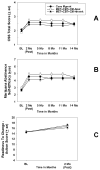Behavioral treatment for marijuana dependence: randomized trial of contingency management and self-efficacy enhancement
- PMID: 23254227
- PMCID: PMC3558664
- DOI: 10.1016/j.addbeh.2012.08.011
Behavioral treatment for marijuana dependence: randomized trial of contingency management and self-efficacy enhancement
Abstract
Objective: The purpose of the present study was to develop a treatment for marijuana dependence specifically designed to enhance self-efficacy.
Method: The participants were 215 marijuana-dependent men and women randomized to one of three 9-week outpatient treatments: a condition intended to enhance self-efficacy through successful completion of treatment-related tasks (motivational enhancement plus cognitive-behavioral treatment plus contingency management reinforcing completion of treatment homework; MET+CBT+CM(Homework)); a condition that controlled for all elements except for reinforcement of homework (MET+CBT+contingency management reinforcing drug abstinence; MET+CBT+CM(Abstinence)); or a case management control condition (CaseM). Participants in the two MET+CBT conditions were also asked to complete interactive voice recordings three times per week during treatment to confirm homework completion.
Results: All patients showed modest improvements over time through 14months, with few between-treatment effects on outcomes. Latent Class Growth Models, however, indicated that a subsample of patients did extremely well over time. This subsample was more likely to have been treated in the CM(Abstinence) condition. In turn, this treatment effect appears to have been accounted for by days of continuous abstinence accrued during treatment, and by pre-post increases in self-efficacy.
Conclusions: The most effective treatments may be those that elicit abstinence while increasing self-efficacy.
Copyright © 2012 Elsevier Ltd. All rights reserved.
Conflict of interest statement
None of the authors have any financial or other relationships that might lead to a conflict of interest.
Figures




References
-
- Amrhein PC, Miller WR, Yahne CE, Palmer M, Fulcher L. Client commitment language during motivational interviewing predicts drug use outcomes. Journal of Consulting and Clinical Psychology. 2003;71:862–878. - PubMed
-
- Andruff H, Carraro N, Thompson A, Gaudreau P. Latent Class Growth Modelling: A Tutorial. Tutorials in Quantitative Methods for Psychology. 2009;5:11–24.
-
- Annis HM, Davis CS. Assessment of expectancies. In: Donovan DM, Marlatt GA, editors. Assessment of addictive behaviors. New York: The Guilford Press; 1988a. pp. 84–111.
-
- Annis HM, Davis CS. Self-efficacy and the prevention of alcoholic relapse: Initial findings from a treatment trial. In: Baker TB, Cannon DS, editors. Assessment and treatment of addictive disorders. New York: Praeger Publishers; 1988b. pp. 88–112.
-
- Annis HM, Davis CS. Relapse prevention. In: Hester RK, Miller WR, editors. Handbook of alcoholism treatment approaches. New York: Pergamon Press; 1989. pp. 170–182.
Publication types
MeSH terms
Grants and funding
LinkOut - more resources
Full Text Sources
Other Literature Sources
Medical
Miscellaneous

